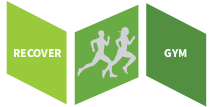The knee joint, which is also called art. Genus is one of the most complicated joints in the body. It’s very dependant of passive stability from; ligaments, meniscus and bone structure as well as active stability, which is covered by all the muscles throughout the knee.
The knee joint also has the two longest bones connecting to each other. Which means there also is a lot of moment and load around the knee area. Therefore the knee has to be very strong.
When injuries in the knee does occur, they are very often quite serious. And if caused by trauma they are often very serious.

Find your injury in the list below:
Chondromalacia patellae
- Uneven collagenous tissue.
- Basic degenerative changes.
- Many repeated minor hits against the knee cap.
- Dietary factors.
- Ekstra ossificanisering (knogle udvækst.
- Muscular atrophy or elevated tonus of m. vastus medialis.
- General hip, knee, lower leg muscle asymmetry.
- The iliotibial tract or band is too rigid along with m. Vastus lateralis.
- General ligament laxity (loose ligaments around the knee cap).
- The back – excessive curvature.
- L3 dysfunction (lumbar vertebra 3).
- Bone dysfunction.
- Leg length difference.
- Foot and ankle deficits due to for example flat foot or overweight.
Patellofemoralt smertesyndrome
- Diffuse pain in the knee and back of the knee cap connected to exertion or strain
- Acute injury.
- Tight muscles and asymmetry.
- Discomfort exacerbated when walking or running on hills or stairs, especially downwards.
- Pain and stiffness experienced when moving from sitting to standing after a rest period.
- Discomfort is exacerbated by squatting position.
- Occasionally accumulation of fluid in the knee joint occurs.
Cruciate ligament injury
Kneecap dislocation / Patella luxation
- Bleeding which causes severe swelling of the kneecap.
- Soreness especially on the inner edge of the kneecap.
- Reduced or no movement in the kneecap.
- Knee deformity.
- Luxation will show misalignment of the kneecap.
Runner’s knee syndrome
- Pain located at the lateral femur epicondyle (outermost bony prominence under the knee).
- Signs of inflammation on the outside of the knee region.
- Worsening pain / condition when running downhill.
- Swelling at the lower part of the knee joint.
- Fluxation (?) of the bursa (irritation).
Ligament injury in the knee
- Valgus trauma is impact on the knee from the lateral side / outside or on the foot from the medial side / inside, where the lower leg is moved outward relative to the femur.
- Varus trauma, impact affecting the knee from the media side / inside.
- Trauma resulting in hyperextension / backward motion of the knee or strong flexion / bending of the knee.
- Rotational impact without body contact.
Jumper’s knee
- Pain under the apex patellae (inside the bottom of the kneecap), especially after exertion, for example from knee flexion with strain.
- Pain, restlessness and stiffness after activity.
- Pain when tightening the quadriceps muscle while the knee joint is loaded.
Meniscus injury in the knee
- Pain proportional to activity level. (constant pain at 51%)
- Pain in rotation or knee bending, primarily near full flexion (knee bending.)
- Pain along the edge of the joint. (60% have pain along the joint line.)
- Weakness or instability of the knee.
- The leg “gives in”.
- Leg locking-up.
- General knee pain.
- Swelling / effusion. (Seen out at approximately 43% of patients with meniscus injuries on the inner side of the knee.
Osgood-Schlatter’s disease
- Pain at the site of attachment for the tendon on tibial tuberosity.
- The pain is triggered by loading the quadriceps muscle, the pain can be triggered immediately for some or with loading over time for others.
- Swelling over the attachment of the tendon.
- Signs of inflammation of the area.
Knee instability
- Noticed or heard a popping or clicking in the knee.
- Leg is collapsing.
- Lack of control of the knee.
- Pain and swelling, especially after exertion.
- Atrophy, (decrease of muscle mass).
- The knee feels hot.
- Pain and stiffness can be experienced when moving from sitting to standing position after a rest period. The pain worsens in a squatting position.
Osteochondritis dissecans
- Pain connected with severe stress, especially at hyperextension (extreme knee joint extension).
- Effusion / swelling that is indicative of a light condition (synovitis).
- Lock-up of the knee.
- Diffuse pain in the knee.
- Inspection of the joints through arthroscopy may be indicative of the treatment plan. Possibly. “Mice” can be removed via arthroscopy.
Osteoarthritis of the knee
- Pain in the knee when active which gets a little better with rest.
- The knee swells if it has been overloaded.
- Feeling of heat in the joints.
- Stiffness in the knee, especially in the morning or when you have been sitting for a while.
- Lack of mobility, making it difficult to get in and out of cars, get up from a chair, walk up and down stairs or up a hill.
- When you move your knees, there may be creaking and crackling sounds.

Social Medier